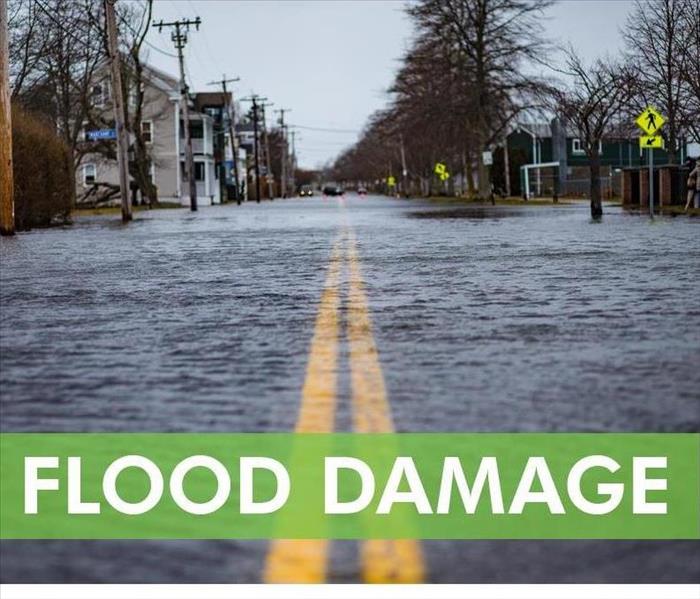Recent Storm Damage Posts
How To Conduct an Emergency Drill in a Commercial Building
8/27/2022 (Permalink)
 People evacuating a building in Trenton, OH.
People evacuating a building in Trenton, OH.
Steps To Run a Drill
A fire drill does not only prepare you and your employees for potential blazes in your commercial property. It can also help everyone learn how to evacuate the premises during major storms that damage the building.
Drills alert you to potential issues so you can correct them before an actual emergency occurs. Ideally, you should hold storm drills for your Trenton, OH, building at least twice annually. Here are some tips for making the most out of these drills.
1. Make an Evacuation Plan
Before you hold your next drill, ensure everyone in the office knows and understands the evacuation strategy. Map routes to the nearest exits and highlights the locations of the alarms. You should also create a communication system that keeps each employee informed about the status of the storm.
2. Set Goals
Judge your fire drill based on how long it takes everyone to evacuate the building and shut down the equipment. Set a realistic time frame for the completion of the drill and try to meet or beat that goal.
3. Rehearse
Start by doing a walkthrough of the drill with members of the emergency response team. Then hold the drill with as many of your employees as possible.
Once everyone has mastered the basic evacuation strategy, try adding some obstacles such as broken elevators and blocked stairwells. To make the drill even more realistic, have a designated employee practice calling 911 and/or cleanup and restoration professionals.
4. Observe
Have a few members of your team observe the drill in its entirety. They should specifically look for behaviors or problems that could be dangerous during a real storm. These individuals can then hold a debriefing after the drill to discuss anything that went wrong.
The above steps should help you run an efficient and effective fire drill. This way, if a severe storm forces you and your employees to evacuate, everyone will understand what to do.
How To Avoid Musty Smells In Your Home
7/15/2022 (Permalink)
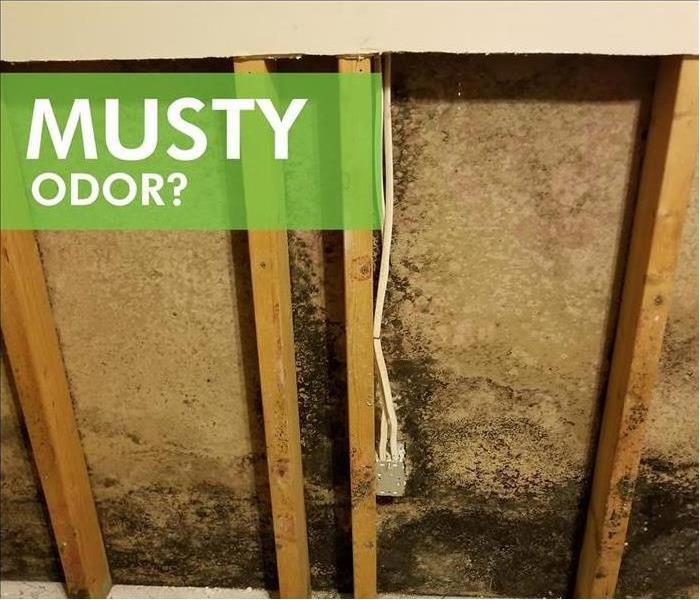 Serious flooding can affect your home and cause foul smells from mold growth.
Serious flooding can affect your home and cause foul smells from mold growth.
How To Avoid Musty Smells In Your Home
When storms cause serious flooding and affect your Morgan Township, OH, home, you may notice several different types of foul odors in the aftermath, even when the waters recede. From mold growth to sewage chemicals, the flooding may leave your home smelling less than pleasant. Learning to identify these odors can be the first step to finding and eliminating their cause.
Musty Smells
If you detect an odor like wet dirty laundry after a flood, then you may be dealing with mold. There are many different types of fungi that can take hold after a flood, and many can develop as soon as 24 hours after the event. Mold does not require sunlight to grow and may grow unchecked in a variety of locations:
- Behind drywall
- Around insulation
- Under carpeting
Having your home inspected after a serious flood can help to uncover hidden mold.
Sewer Odor
The strong, bitter smell of a sewer is hard to mistake for anything else. The odor may also smell like rotten eggs, especially if a nearby sewer has malfunctioned and sewage loss caused a flood in your home’s basement. Because any standing water in your home may contain contaminants and bacteria, you may want to seal off the area until you can call a water damage and mitigation service to come to drain it away and deodorize your home so the offensive smell from the flood water does not linger.
Dirt or Mud Smells
Serious flooding can bring silt, dirt and debris into your home. The moisture it contains can also encourage increased mold growth. You may detect an earthy, fishy or wormy odor from dirt or mud left behind in the wake of a flood. Your flood technicians can remove this debris and offer you options for odor removal as well, such as using ozone machines to clear the air.
Serious flooding in Morgan Township, OH, can affect your home and cause foul smells from mold growth and dirty standing water. Learning how to identify different odors can give you a head start on cleanup efforts, especially once help arrives.
What Is Category 3 Water Damage?
4/25/2022 (Permalink)
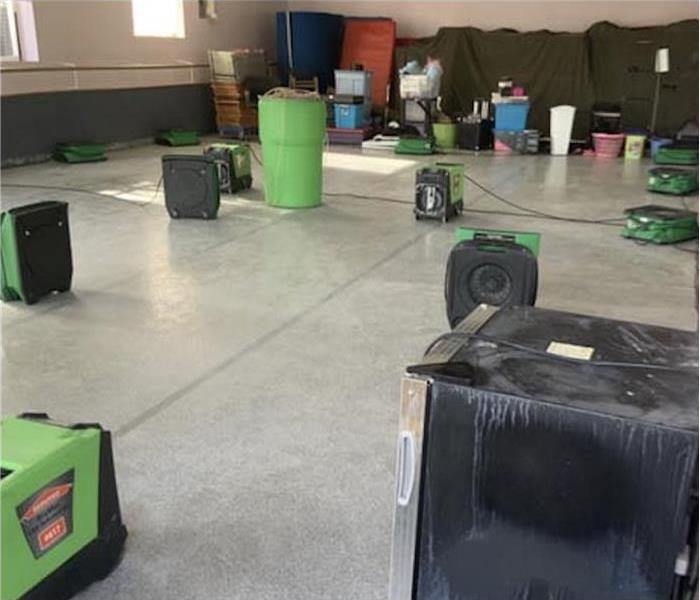 Commercial water damage clean-up in Hanover Township, OH.
Commercial water damage clean-up in Hanover Township, OH.
If your commercial property in Hanover Township, OH, has been affected by a flood or other water issue, chances are you are dealing with some level of water damage to your building. Depending on the type of water issue you have had, you may be dealing with category 1, 2 or 3 water damage. If you have category 3, the most severe type, there are a few things to know to help you clear it out quickly and safely.
What Is Category 3 Water?
Category 3, or black water, is the most contaminated level of water damage. lt is highly contaminated with bacteria and microorganisms and can come from many places, such as:
- A sewage problem, such as a backed-up toilet, sink or shower drains
- Burst pipes
- Standing water from a natural disaster, such as a flood
What To Do If You Find Black Water
If you have a sewage problem or water damage from a flood, you should call in a professional water restoration company to help you deal with the aftermath, as there is a chance you have black water. Although it is safe to try to remove water if it is clean water, black water should only be cleaned by professionals who are wearing the proper personal protective equipment. Keep yourself and any building residents away from the source of the water damage until help arrives.
How To Restore Your Building
A restoration company will help you begin the restoration process for your commercial building. Any items inside your building that have been affected by the water damage or may have absorbed the water may have to be replaced. Ensure that everything has been sanitized and cleaned before building residents return.
If your commercial building has been affected by water damage, it's important to identify the category of water damage your building has been impacted by. Calling in a restoration company. quickly can help you get back to normal as soon as possible.
How Are Odors Removed After Flooding?
4/11/2022 (Permalink)
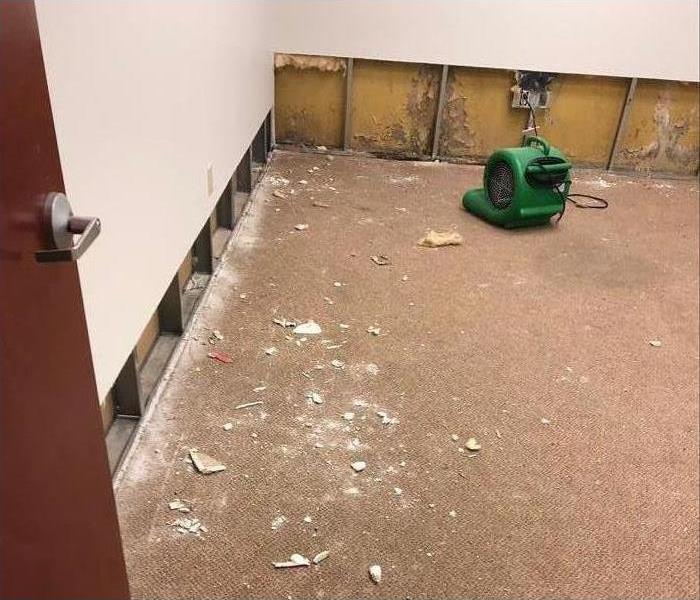 Mold damage behind walls in Hamilton, OH.
Mold damage behind walls in Hamilton, OH.
After a Flood, How Are Odors Removed?
After a flood strikes a business or your commercial building, it leaves a disaster in its wake. Not only does the moisture encourage explosive black mold growth, but a toxic residue is also often left coating everything the floodwaters touch. It’s why buildings smell so awful afterward.
Usually, you’ll need a top restoration expert to inspect and remediate the damage caused by floodwater. They have access to custom sanitizers and equipment to remove toxins, mold and odors. They use a range of methods to get the best results, including
Abrasive cleaning
Dry cleaning
Foam cleaning
Immersion cleaning
What Causes the Odors?
Probably the most noticeable smell is the strong musty odor. This is from mold growth, which loves the inside of buildings. Drywall and wood provide food for the mold, while the mold spores are always all around us. All it needs to grow is excessive humidity.
Floods also frequently leave a toxic sludge covering everything. Items such as ceramic tile and other non-porous surfaces can often be cleaned with a spray and wipe using ordinary sanitizers, but porous items will absorb the water and residue. During a flood, it’s normal to have sewage loss mix in with the flood water which gets everywhere. It’s also responsible for some of the worst odors.
Can Odors Be Removed or Do You Have to Replace Everything?
Using proprietary cleaning agents, restoration experts often can save items instead of replacing them. This not only saves money, it often can save irreplaceable items. SERVPRO leaves your commercial building “Like it never even happened.”
To facilitate the odor removal process, they’ll bring in large-volume air movers and clean everything that was touched by the flood. they can often save essential paperwork and documents, too, using very advanced methods such as freeze-drying and vacuum thermal drying. Future mold growth will also be inhibited by the moisture removal process.
The key is to get reopened as quickly as possible for your business to survive. Your Hamilton, OH, restoration technicians are trained to expedite service for commercial customers.
Odor removal is usually easy and quick for professional restorers. The sooner they start, the more effective it’ll be.
Your Flood Preparation Guide: What To Do When a Major Storm Is On the Way
1/11/2022 (Permalink)
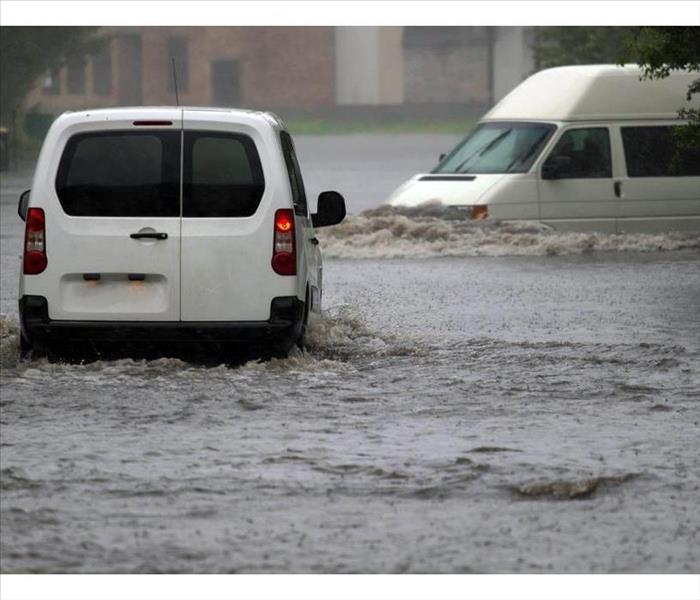 Do not drive on a flooded street.
Do not drive on a flooded street.
Storm Preparation Plan
If you live in a flood zone, it is imperative that you have a storm preparation plan in place that will keep both you and your home safe from flood water and the damage it can cause. If you don't currently have a plan in place, now is the time to create one, as storm season is well under way in most parts of the country, and floods can come out of nowhere and may do the following:
- Result from excessive rain or snow, coastal storms, overflows, or storm surges
- Develop slowly or quickly, such as a flash flood
- Cause power outages, resulting in costly water damage, disrupt transportation and create landslides
Because floods are often the result of common natural events, such as rain, and because they can come on suddenly, the best thing you can do for your safety is prepare.
What To Do When You Are Under a Flood Warning
If your area is currently at risk of being inundated by flood water, there are certain measures you should take to stay safe. Some such measures include the following:
- Do not attempt to navigate the flood waters via any means, whether by walking, driving, swimming, or boating.
- Steer clear of bridges that go over fast-moving water.
- Evacuate your home if ordered to do so.
What To Do During a Flood
If your home is at risk of becoming flooded, move to higher ground immediately, but only if there is a clear path out of the flooded area. Otherwise, stay where you're at. If you're trapped in a flooded building, turn on your radio and tune into NOOAA Weather Radio, EAS or the local alerting system for instructions on how to proceed. DO NOT go into the attic, as you may become trapped by rising water. If necessary, climb out onto the roof and flag for help.
What To Do After a Flood
If flood water has caused excessive water damage to your home, contact your Ross, OH, flood remediation team as soon as the waters have begun to recede. The right team can help dry out your home and restore it to pre-flood condition.
3 Tips for Roof Preservation
11/9/2021 (Permalink)
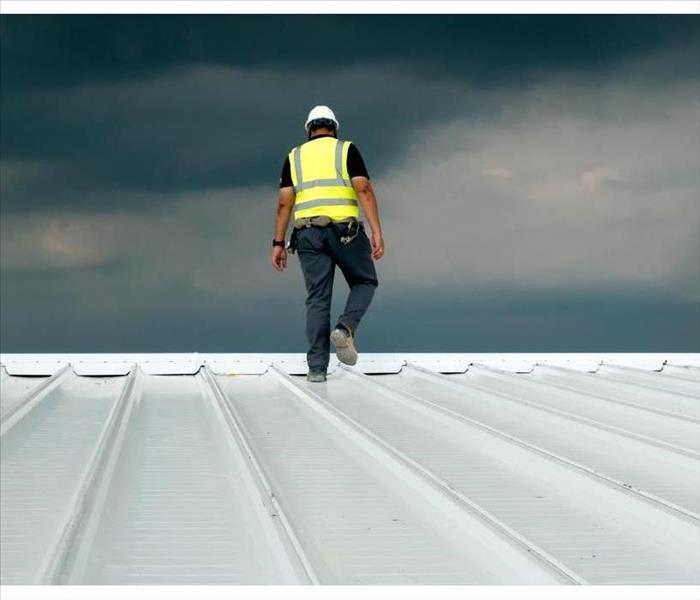 If you find a problem with your roof it's a good idea to promptly perform any repairs.
If you find a problem with your roof it's a good idea to promptly perform any repairs.
Roof Preservation For Your Building
When your business is located in Deer Park, OH, you probably know that a roof leak is no laughing matter. A roof is designed to protect your company from numerous types of inclement weather, including snow, ice and the blazing hot sun. However, a roof can do its job only if it’s kept in good repair. Here are a few tips you can use to help preserve your roof’s integrity.
1. Perform Regular Maintenance Checks
Many professionals recommend doing roof maintenance check twice a year. However, if your business has an older roof or is located in an area where you experience frequent bad weather, you may desire to have a check performed more often. A maintenance check can allow you to find and repair any damage early before larger damage occurs.
2. Look for Signs of a Roof Problem
Maintenance should include looking for signs of rain, snow, or wind damage, as well as cleaning out gutters and drains. You may also want to ensure that vents and other equipment are properly sealed and that previous repairs are still intact. If anything is amiss, then it's best to call a professional to conduct repairs before a major problem occurs. If you do experience a roof leak, then water damage professional can advise you on the proper repair and cleanup procedures.
3. Do Repairs When Damage Occurs
Even wind damage can lead to leaks and other issues with your roof. It's a good idea to have any repairs made as soon as possible after a problem is detected. Having repairs made in a timely manner may save your business from a more costly roof replacement.
When you live and work in Deer Park, OH, you know roof preservation is important. Performing regular maintenance checks and knowing what signs can indicate a problem may allow you to catch a roof leak before major damage occurs. If you do find a problem with your business's roof, it's a good idea to promptly contact a professional to perform any needed repairs.
4 Ways to Prevent Mold After Your Home Floods
9/18/2021 (Permalink)
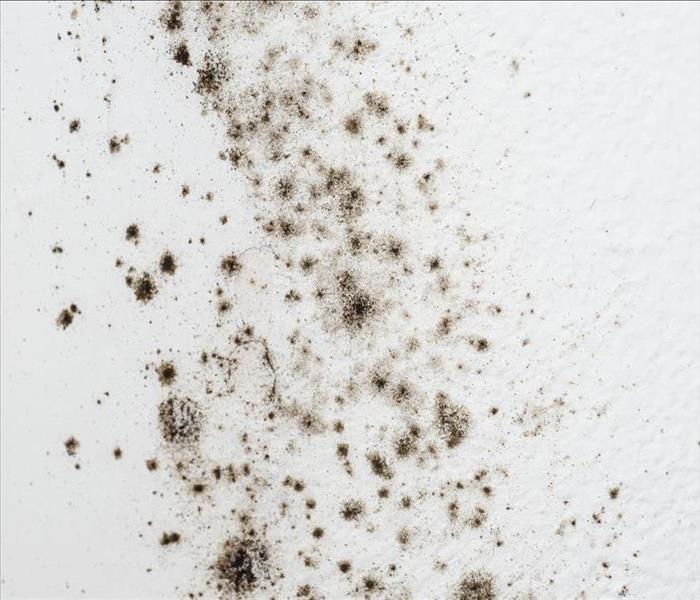 Mold growth can start within 24 hours of flooding.
Mold growth can start within 24 hours of flooding.
You should act immediately to prevent mold from starting to grow in your home after a flood in Hamilton, OH. Document the damage for insurance purposes and then take steps to dry out your home. Mold growth can start within 24 hours of flooding, but you can limit the likelihood that it will become a serious problem. Here are four ways to prevent mold after a flood.
1. Get Rid of Moisture
The most important mold prevention method is eliminating the presence of standing water and residual moisture. Depending on the severity of the flood, you may want to hire a professional water damage restoration service to pump water out of your house.
2. Clean the Affected Area
Water from a flood is considered Category Three or black water, meaning that it may contain chemical contaminants or sewage overflow. Areas of your home exposed to flood water should be cleaned before being dried and restored.
3. Thoroughly Dry the Affected Area
In addition to air movers or fans, you may also want to use dehumidifiers to dry out porous or semi-porous building materials and contents. You may need to get rid of carpet, which tends to trap moisture and contaminants that can lead to mold growth.
4. Clean or Replace Damaged Contents
Once the affected area is dry, you can determine which building materials must be torn out and replaced and deal with damaged contents. Most non-porous contents can be cleaned. Porous items of significant monetary or sentimental value may be worth restoring with specialized methods.
By following these tips, you may not experience mold growth after flooding, or the problem will be less severe than it would have been otherwise. If mold does form in your home in Hamilton, OH, you may be able to retain the services of the same residential damage restoration company to provide mold removal.
5 Steps to Prevent Mold Growth After a Flood
8/4/2021 (Permalink)
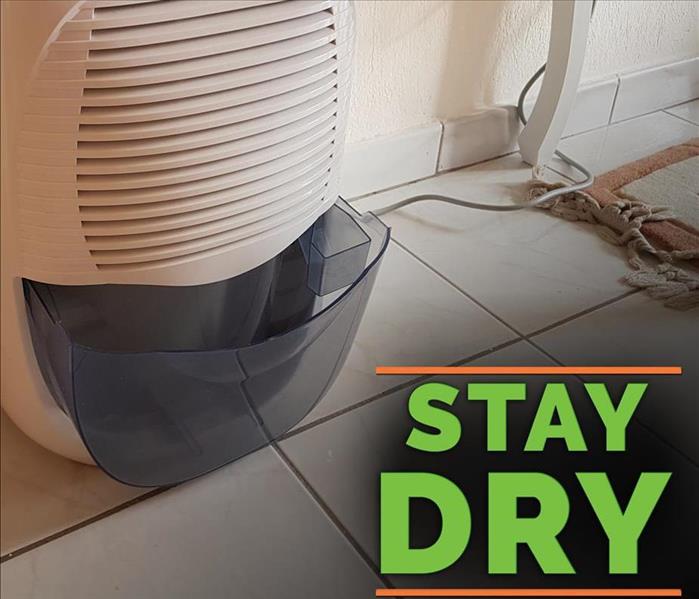 A dehumidifier will remove the moisture from the area.
A dehumidifier will remove the moisture from the area.
Prevent Mold Growth In Your Home
If your Hamilton, OH, home has experienced a flood following a storm, you might be considered about mold growth, as you should be. After flooding, homeowners only have about 36 hours to act before mildew and mold can start to grow. Fortunately, there are steps you can take to prevent mold from growing in your home.
1. Remove Wet Items
The first thing to remove from the home is big, wet items like furniture, curtains and pillows. They can hold a lot of moisture, so move them to the driveway or garage until they dry out completely.
2. Use a Wet Vac
Shop vacs or web vacs can remove water from wet carpets. If you don’t own a shop vac, you can rent one from a hardware store. You can also hire a professional to come in and take care of your carpets for you.
3. Air Out the Area
It might be a good time to invest in a dehumidifier, which will remove the moisture from the area. Fans can also help. If rain has stopped, open doors and windows to give the water somewhere to escape.
4. Remove Molding and Baseboards
Baseboards and crown molding look beautiful but can prevent the walls from completely drying. Removing all molding from the walls exposes them to air so that they can better dry.
5. Cut Small Holes In the Wall
Walls made out of sheet rock are especially vulnerable to mold growth. Allow them to dry out by cutting small openings along the bottom of the walls. This lets air reach the covering on the inside of the walls in addition to the outside.
These steps will help prevent mold growth in your Hamilton, OH, home. Still, after a few days without power, mold can start to grow. Contacting an expert can help you determine the best route for mold removal.
3 Steps To Protect Your Pipes From Winter Storms
4/19/2021 (Permalink)
 Be sure to contact professional water damage specialists as soon as possible.
Be sure to contact professional water damage specialists as soon as possible.
Steps To Prepare Your Pipes For A Cold Season
Winter can be a tough time for businesses in Morgan Township, OH. When you are already worrying about snow and ice removal and keeping your customers and employees safe, you don't want to also be forced to deal with a burst pipe. Here are three steps to getting your pipes ready for a cold season.
Remove Water From Outside Lines
Draining water from any water lines that have direct exposure to extreme cold is imperative to keeping your system in good working order. Disconnect garden hoses and sprinkler supply lines. Close off your outdoor hose bibs:
- Locate the shut-off valve and turn off the water supply.
- Place a bucket under the spigot and turn the water on, allowing it to run until the water in the line is removed.
- Leave the spigot open so that any water that may leak into the line is able to drip out instead of freezing in the line.
Insulate
A frozen pipe can end in disaster, with standing water that wreaks havoc on your building. Help prevent this by properly insulating your building and your plumbing. Be sure to pay special attention to areas where water supply lines are located in unheated areas such as garages. Install pipe sleeves or heat tape as needed to help in these areas.
Keep Them Warm
Take additional precautions when you know extreme cold is coming. Keep garage and service doors closed and open kitchen and bathroom cabinets to allow warmer air to circulate around pipes. Turn the water on to a trickle on any faucets served by exposed pipes. This will allow some water to move through the system to prevent freezing. If your efforts fail and a burst pipe results in a mess, be sure to contact professional water damage specialists as soon as possible to get a headstart on proper cleanup.
Don't let a burst pipe throw a wrench into your business plan. Follow these steps to get your plumbing ready for the cold winter weather.
The Best Cleaning Methods for Flood-Damaged Contents
1/13/2021 (Permalink)
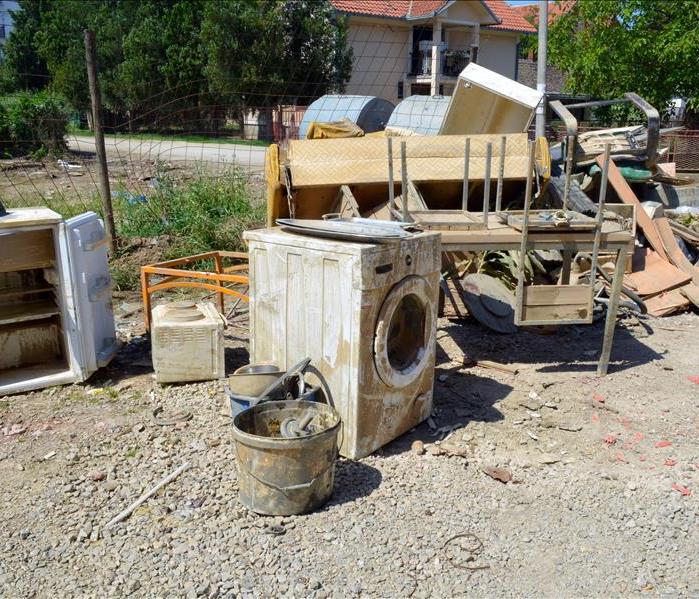 Flood-damaged contents in Trenton, OH
Flood-damaged contents in Trenton, OH
The Best Cleaning Methods for Flood-Damaged Contents
Any contents of a home that are exposed to flood water should be disinfected, cleaned, and deodorized. While homeowners may be able to clean up some limited flooding damage, the risk of mold can be greatly reduced by having content cleaning professionals remove items for off-site treatment and determine whether porous items can be restored to a residence in Trenton, OH.
Disinfection
A wide range of cleaning products are used to clean contents that have been exposed to flooding. Depending on whether items are porous or non-porous and the level of durability, any of the following solutions or systems may be used:
- Foam cleaner
- Liquid disinfectant
- Wet-wash machines
Content cleaning experts may recommend dry cleaning some delicate materials. While standard dry cleaning does not disinfect items, the application of heat during ironing, steaming or pressing processes eliminates some contaminants.
Stain Removal
Beyond disinfection, items may require cleaning to remove stains. Abrasion, immersion, spot, wet or dry cleaning may be effective methods for restoring the appearance of items that have become stained during or after flooding. Items that are severely stained by black water may be replaced prior to cleaning if doing so is more cost-effective than attempting cleaning.
Deodorization
Flood odor may linger in a location even after cleanup of the area and contents is complete. A deodorization treatment such as hydroxyl, ozone, or thermal fogging may be helpful for banishing residual odors in a location that was previously flooded. Pay close attention to musty odors, as these may originate in microbial volatile organic compounds or mVOCs released during the growth cycle of mold.
Some porous items cannot be fully disinfected or are not cost-effective to clean. These contents should be disposed of, reported as losses, and replaced. Expensive or rare objects may be restored through specialized content cleaning methods. Consult with storm damage restoration experts near Hamilton, OH.
5 Ways to Prepare Your Business Before a Storm
11/10/2020 (Permalink)
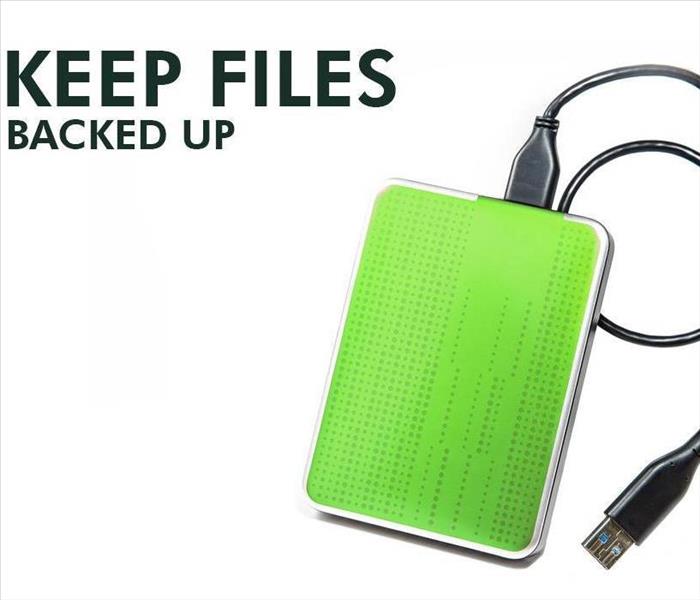 Back up your information to an external drive to keep them safe
Back up your information to an external drive to keep them safe
Disaster Preparedness Tips
Disaster preparedness can help keep your Oxford, OH, business running smoothly after a storm. There are several steps that you can take to get ready when you are expecting severe weather.
1. Back Up Important Documents
Whether flooding from the rain damages your electronics or a power surge ruins a computer hard drive, this can lead to the loss of important files. Back these up onto cloud storage or an external drive to keep them safe.
2. Move Objects to Higher Floors
If you are expecting a flood, move important or expensive items, such as paper documents, upholstered furniture and computers, to a higher floor. This will keep them from absorbing water in case it gets inside the building.
3. Inspect the Building
Your building is more likely to be affected by severe weather if it is already damaged. An essential part of disaster preparedness is inspecting the building and making necessary repairs. You can hire a cleanup and restoration company to do this for you.
4. Create an Emergency Plan
Business preparedness should also include a plan for dealing with emergencies while you are at work. Know what you will do if the power goes out or the weather becomes dangerous. Make sure all of your employees know what to expect during this situation.
5. Prepare to Work From Home
Something else that you can do to keep everyone safe is to make plans to work from home. This will eliminate the need for travel in hazardous conditions while allowing you to remain productive. If you need to, find a way to keep everyone connected during this time, so you can get in touch for any necessary discussions.
Using these tips for disaster preparedness, you can limit the ways in which a storm will affect your business. It is important to keep not only your building safe but your employees as well. Take the time to account for both in any plans that you make.
Fortune Favors the Prepared
9/8/2020 (Permalink)
 Prepare yourself and your employees by signing-up for First Aid and CPR training
Prepare yourself and your employees by signing-up for First Aid and CPR training
Are You Prepared?
Every business owner in Ross, OH, should have a plan to stay in business in the event of a natural or man-made disaster. Why? Business preparedness protects your hard-earned investment and improves the chances of uninterrupted operations during a crisis. Effective disaster preparedness comes down to common-sense measures that can help you manage an emergency and ensure your business' recovery from disruption. Here are some ideas:
Plan
Stay informed. Assess your business's risk against different potential disasters.
Determine which employees, resources, and equipment are essential to operations and survival.
Devise nonstandard ways to work with key customers and contractors during and after a disaster.
Develop alternate relationships with "just-in-case" suppliers. Avoid reliance on one vendor.
Formulate options if your workplace is inaccessible.
Plan for post-disaster recovery by collaborating with a local disaster response and restoration company.
People
Write a Crisis Communications Plan outlining fallback communications with employees, local authorities, customers, and suppliers.
Maintain a fully-stocked emergency supply kit, First Aid pack, and sanitation and "seal the room" provisions.
Encourage employees to bring in customized emergency kits.
Prepare yourself and your employees by signing-up for First Aid and CPR training.
Develop an evacuation plan, specifying a chain of command, assembly site, and emergency routes.
Create a shelter-in-place plan, to include protective "seal-the-room" measures.
Coordinate with collocated businesses to conduct joint emergency exercises.
Review business preparedness plans annually with employees.
Protect
Check your business insurance coverage, to include losses from physical damage or destruction.
Prepare for utility disruptions by considering back-up options.
Store extra supplies, materials, and equipment to ensure post-crisis business continuity.
Keep smoke alarms, fire extinguishers, and emergency lights in good working order.
Store copies of business-critical documents and records in a water-proof, fire-proof container.
Disaster preparedness is an investment in your business' future. While no one wants to dwell on potential disaster scenarios, it's good business to remember that fortune favors the prepared.
What Can Be Saved After Your Home Floods?
8/3/2020 (Permalink)
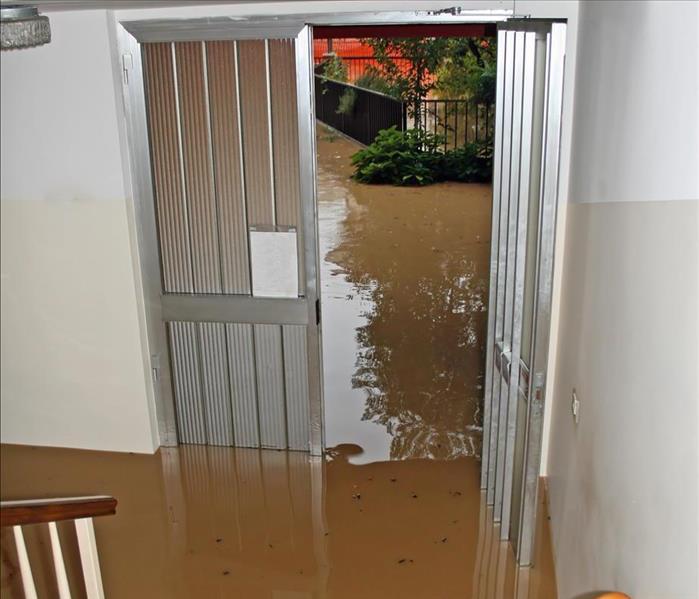 Floodwaters in Oxford, OH
Floodwaters in Oxford, OH
If your home in Oxford, OH, ever fills with floodwater, conduct a thorough content cleaning before your return. While some items may be salvageable, other items will not.
Levels of Contamination
Floodwaters have three danger levels:
1. Clean Water
Clean water comes from a clean source, such as a broken supply line. While not harmful, this water might become dirty over time.
2. Gray Water
This second level contains some contamination. Washing machine and toilet overflow fall into this category.
3. Black Water
The most contaminated grade, black water may include chemicals, microbes or even sewage and must be removed.
Even if you believe your house has only suffered clean water damage, there is a chance gray or black water has intruded without your knowledge. This means comprehensive content cleaning is always required.
What Must Be Thrown Away
Except for canned goods and food inside intact, airtight plastic containers, discard all consumables, including pet food. Your medicine should also be disposed of, so acquire refills for prescriptions. Anything porous that has come in contact with polluted water must be trashed.
What Can Be Recovered
Hardwood and composite cabinets, upholstered furniture and drywall may be reparable. If these areas have sustained damage, hire a flood restoration professional for a comprehensive rebuild. Appliances and electronics may be reused once inspected by a technician, provided they have not been submerged. Non-porous toys can be cleaned with detergent and disinfectant. Damp mattresses may be dried using towels, but bedding that has come in contact with corrupted water needs to be abandoned. To determine if your carpet can be kept, pull on a corner. If you find yourself holding a fistful of fibers, it must be replaced.
After a flood, executing an intensive content cleaning is imperative before moving back into your home. Careful determination of what can and cannot be saved will keep both you and your family safe.
What To Know About Damage You Can Expect from a Storm
4/23/2020 (Permalink)
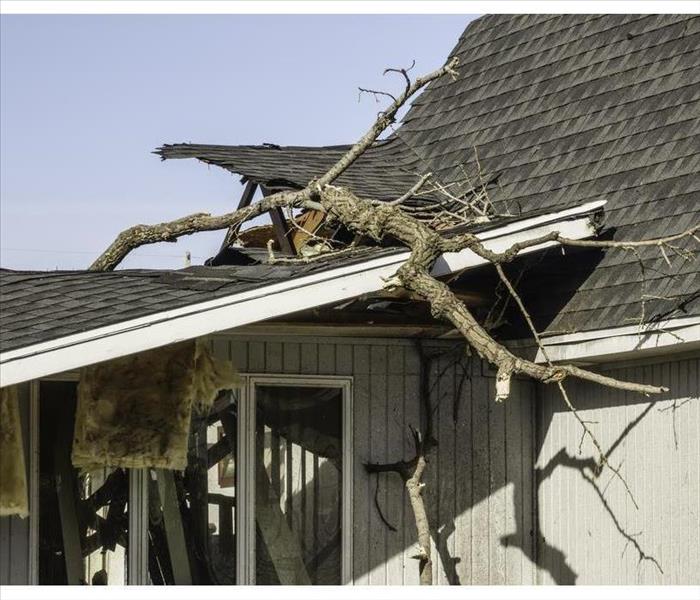 Roof damage in Ross, OH
Roof damage in Ross, OH
Here Are Three Things You Should Know
After a storm at your Ross, OH, home you may find that a storm restoration is needed. There are a few things you can expect to see in that damage that occurs after a storm from flooding that leads to a tear out, to wind that harms the roof. Here are three things you should know.
1. There May Be Multiple Damage Types
It’s important to understand that multiple types of damage can occur after a storm. High winds can lead to roof damage, or pick up debris and blow them into the building. Heavy rains can lead to flooding and water damage, while cold temperatures can cause problems with freezing pipes.
2. There May Be Multiple Damage Locations
Because of the variety of damage types, a storm can bring, it’s important to note that damage can also occur simultaneously in multiple locations. This means that due to flooding you may need a tear out, or removal of damaged wall material, while at the same time the roof has some loose shingles that need to be fixed. This is why many homeowners choose to work with a restoration service when your home sustains storm damage.
3. There May Be a Need For Professional help
If you find your home has sustained storm damage, then it’s recommended that you contact a local restoration service to help with cleanup and repairs. These professionals should be well versed in the different damages that can occur, where to look for them, and how to properly fix each one. With a little time and work they can have your home looking “Like it never even happened.”
There can be a number of damage types after a storm and each may need to be repaired in a different way. But whether you need a flood tear out, or a roof restoration a professional restoration service can help.
How You Can You Protect Your Roof From Hail Damage
3/30/2020 (Permalink)
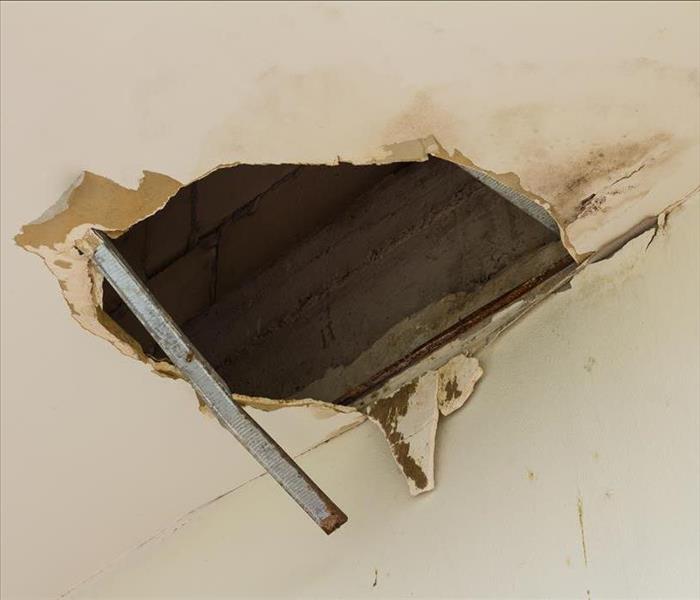 Damaged roof created hole on a ceiling
Damaged roof created hole on a ceiling
How You Can You Protect Your Roof From Hail Damage
When you hear about impending hail, your first instinct is probably to cover any windows. Yet hail can cause other types of storm damage, including:
- Cracked or missing shingles
- Wet insulation
- Water leaks
- Roof damage
This last problem is arguably the most dangerous. After all, holes in your roof can allow water to seep into your Hanover Township, OH, property. You could then be faced with severe flood damage.
That is why you should take steps to protect your roof from hail damage. Below are some tips for securing the top of your property and preventing the need for major storm cleanup.
Use Impact-Rated Equipment
Any skylights on your roof should meet ASTM pressure test standards or have a sufficient missile impact rating. You can also pick lights that are FM-approved. If you choose to install solar panels on your roof, they should also meet the International Electrotechnical Commission's impact-resistance standards.
Protect Your Equipment
Roof damage can also affect any HVAC units on top of your building. Keep them safe with a hail shield or guard.
Inspect Your Roof Regularly
A weaker roof is more likely to get damaged during a storm. You should thus regularly check the area for problems. The drainage system should be inspected at least two times a year. If your building has a roof hatch, you should look out for any loose screws. Any roof-mounted air conditioning units should be secured properly, as well. Fixing any issues in advance should prolong the life of your roof and increase the odds of it surviving a hailstorm.
Hail can destroy your shingles and create water leaks within your property. Hail can also cause major roof damage. You can attempt to mitigate the destruction by protecting your roof in advance. Still, some hailstorms are so powerful that they can harm even well-maintained roofs. If your building does suffer a water emergency due to a damaged roof, flood cleanup specialists can help.
3 Things To Do if Your Home Has Been Damaged in a Storm
11/13/2019 (Permalink)
 Use your home's breaker to turn the power off to the whole building
Use your home's breaker to turn the power off to the whole building
What To Do if Your Home Has Been Affected By Storm
If you have had severe weather in Morgan Township, OH, then you may be dealing with water or flood damage in your home. This can be a distressing situation and, if you are feeling overwhelmed, it can be difficult to figure out what you should do next. The following storm tips can help you determine what to do if your home has been affected.
1. Turn Off Your Power
Perhaps one of the most important storm tips to remember is to cut off the power right away if there is flooding in your home. It is unsafe to use electricity in this situation. You might be tempted to simply turn off the lights and unplug your devices, but this can be dangerous since doing so can produce a spark. You should use your home’s breaker to turn the power off to the whole building instead.
2. Contact Your Insurance Company
Any damage that has been done to your home should be reported to your insurance company as soon as possible. The claims process can be lengthy, and your claim can be denied if you wait too long, so it is best to begin sooner rather than later. Make sure to read over your policy to make sure you understand what to expect.
3. Start Cleaning Up
While you wait for your insurance adjuster to inspect the house, you can begin cleaning up the storm damage. If you don’t, it can contribute to mold growth and other problems. This can increase the amount of time and money it takes to make repairs. In some cases, your claim can be denied if mitigation is not done. You may want to take pictures and make a list of damaged areas while you do this since the adjuster can use this information.
Keeping these storm tips in mind can help you better navigate this stressful situation. If your home has been damaged, a cleanup and restoration company can make repairs and salvage many affected belongings. Once they’ve finished, you may not be able to tell your home was damaged at all.
4 Ways Hail Could Damage Your Business
10/24/2019 (Permalink)
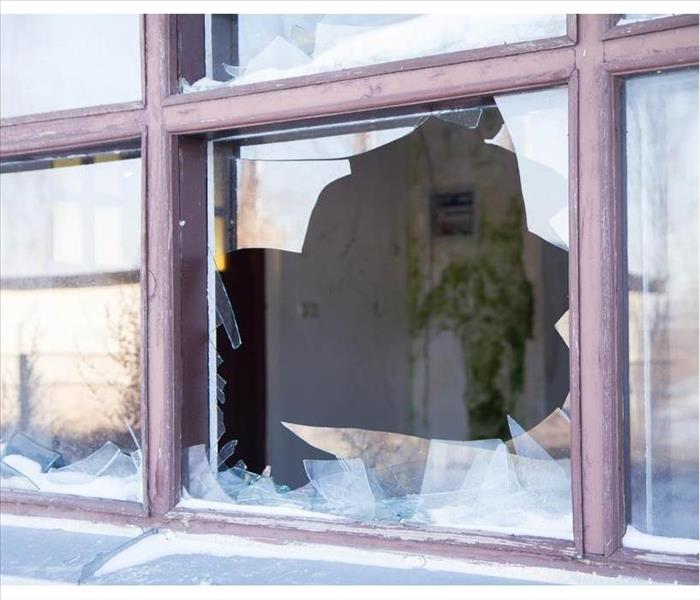 A single broken pane of glass exposes the interior of your business to extensive water damages
A single broken pane of glass exposes the interior of your business to extensive water damages
4 Ways Hail Could Damage Your Business
Hail is more common in some areas of the country than in others, but when hail does hit Reilly, OH, the damage to business property can be serious. Depending on the size of the chunks of ice the type of harm could range from minor roof damage to long-lasting effects inside your buildings.
Damage to the Roof
Of course, the roof is often the first part of the property to be affected by hail damage. Roof damage may include minor dents or dings, or it could include broken and missing shingles. A storm damage cleanup and restoration professional is the best person to identify the extent of roof damage. You don't want to leave your business at risk because you overlooked a spot where shingles are missing.
Broken Windows
A single broken pane of glass exposes the interior of your business to extensive water damages. Hailstones often reach speeds as much as 100 miles an hour. When those hurtling ice stones make contact with your inventory or your equipment, the chance of property damage naturally increases. Of course, there's also the chance that your personnel or customers could be hit by hail, as well.
Property Attached to Your Building
If you have signage, air conditioning units, or any other belongings attached to or set up near your building, large pieces of hail could naturally harm the property. If you have the chance, it's best to move these items inside before the storm gets very bad.
Water Leaks
One of the worst problems caused by hail damage is the long-lasting, hard to recognize type. If water gets into your building, it could soak into the insulation or support the growth of mold in the attic. After the storm passes, you may want to conduct an inspection of your own. If you suspect any damage, contact professionals to complete repairs before extensive property or roof damage takes place.
How Flood Zones Help You Determine Your Risk for Flooding
9/11/2019 (Permalink)
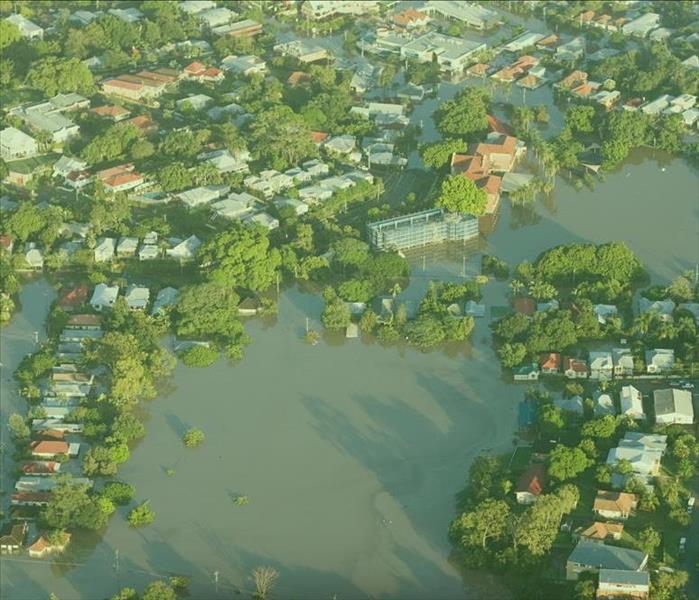 By learning your flood zone, you can take steps to better prepare yourself for this type of event
By learning your flood zone, you can take steps to better prepare yourself for this type of event
When it comes to natural disasters, floods are both common and dangerous. If you own a home in Trenton, OH, it’s important to be aware of your risk for flooding. Follow along below to learn how knowing your flood zone can help you determine this risk.
What Are Flood Zones?
Flood zones are simply areas of land, each with a defined level of risk. Each zone is defined by the Federal Emergency Management Agency (FEMA) and falls into one of the following three overarching categories:
- Special hazard area
- Moderate hazard area
- Minimal hazard area
Within these categories, zones are identified by a letter code. For example, if you’re in a moderate hazard area, you will belong to Zone B or Zone X. You can find definitions for your specific flood zone through FEMA.
Determining Your Zone
Knowing your home’s zone can help you make insurance and property protection decisions. Fortunately, it’s easy to figure out which zone you’re in. The first step is to visit the FEMA Flood Map Service Center website. Here, you can enter your home address to reveal a Flood Insurance Rate Map (FIRM) for your location. Follow the map’s legend to find out your property’s level of risk.
What Are Your Options if You Experience a Flood?
In high-risk areas, a storm with heavy rainfall can easily lead to flood conditions. Luckily, if you experience damage, you have options. If you have flood insurance, check with your agent and begin the process for a claim. You may also want to look for emergency restoration services, which can help you restore your home to its pre-damaged state.
Flooding has the serious potential to damage or destroy your property. As a homeowner, it’s a smart idea to know your risk. By learning your flood zone, you can take steps to better prepare yourself for this type of event.
Are You Prepared for the Storm?
8/14/2019 (Permalink)
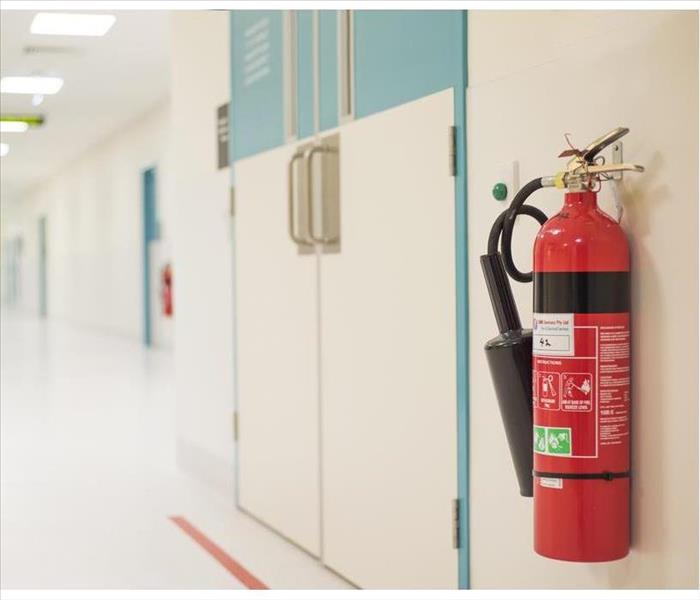 Keep fire extinguishers accessible throughout a property
Keep fire extinguishers accessible throughout a property
Property managers in Oxford, OH have a lot on their plates. While the day-to-day bustle may seem nonstop, time needs to be set aside to ensure your properties and the people in them are ready for anything. Although no building is safe from Mother Nature’s wrath, developing a storm preparedness plan can ensure confident handling of emergency situations.
Develop and Communicate the Plan
Property management often means juggling numerous unique properties. Although each may have its own special requirements, it’s important to develop a general emergency plan. Once that is in place, special needs for each property can be incorporated. This plan needs to be clearly communicated to all tenants and anyone associated with a property.
What Should a Plan Include?
Storm preparedness requires considering all possibilities. A bad storm could result in fires, evacuations, property damage and much more. They key elements of a plan should address the who, what and where of facing whatever may come.
Ensure diagrams are in all buildings that include emergency exits, fir-safe stairwells and other safe spots.
Keep fire extinguishers accessible throughout a property. Include instructions on their proper use.
If a building has an emergency detection system, ensure it is working. If it doesn’t, assign a person and backups to be responsible for calling 911.
Have an established way to contact tenants. This could be through automated voice messages, texts or emails.
Plan for backup communications in case the power goes out.
Plan for Damage
Even with a storm preparedness plan in place, damage can happen. To reduce the risk, keep buildings up to code. Regular maintenance can ensure codes are continually met. In addition to insuring the properties, encourage tenants to obtain renter’s insurance for their own protection.
Once the storm subsides and everyone is safe, that is the time to access the damage. Whether it’s a little or a lot, count on trusted professionals to get your property ready to weather the next one.
Flooding in West Hamilton, OH
7/24/2019 (Permalink)
When flooding damages your Hamilton, OH, home, it can be difficult to know how to proceed with cleanup efforts. One of the first steps you can take is to prepare for the insurance adjuster’s visit once you have filed the claim. Knowing what you will need to make visit simple for the home adjuster can result in a faster payout and less stress for you as the homeowner.
3 Ways To Prepare for an Insurance Adjuster.
- Know What Paperwork You Will Need
Before you call a flood damage and water cleanup service to help with mitigation, call your insurance agent and ask him or her what kind of paperwork you will need to prepare for the adjuster’s visit. You may be able to download and print some forms from the provider’s website. Being well prepared can make the job simpler for your home adjuster and expedite the filing of your claim.
- Make a List of Losses
Before the adjuster arrives, you may want to make a list of all the items that were damaged or destroyed in the flood. Remember to include when you bought them, a copy of the receipt if available and whether any of them have been previously repaired. The more information you can provide, the easier it will be for your adjuster to help you file your insurance claim.
- Make a Video Record
Thanks to smartphone technology, it is simpler than ever to take photos and recordings of any flood damage to your home. Document stains, cracks and new mold growth that might have resulted from standing water. Make copies of photos and ask where you can send your videos so your adjuster can review them if necessary. Remember to back up your videos in case you need them later.
Being prepared to talk to your insurance home adjuster after a flood damages your Hamilton, OH, residence can give you peace of mind. Working efficiently with this knowledgeable individual might result in a quicker insurance payout so you can get started on repairs right away.
How To Deal With Mold Damage After Flooding
7/21/2019 (Permalink)
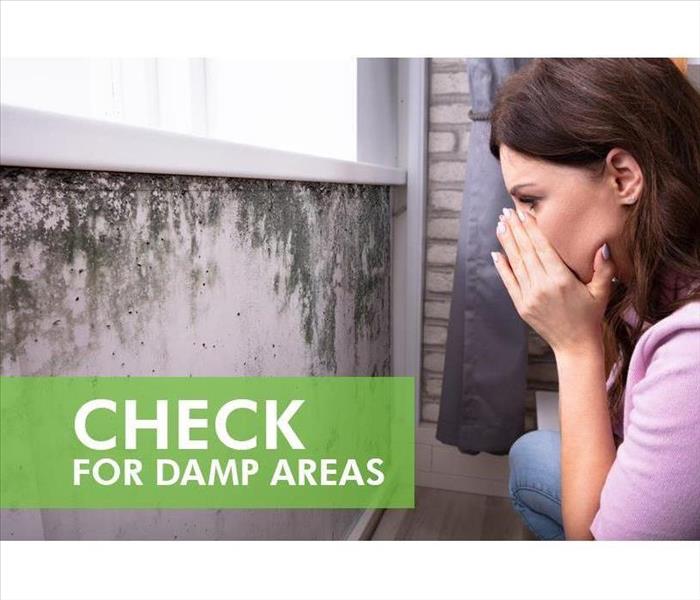 Mold thrive in damp environments and is common in flood-damaged buildings
Mold thrive in damp environments and is common in flood-damaged buildings
When your home in Trenton, OH, is affected by a flood, the excess moisture left behind can quickly lead to mold growth. The presence of mold can have a big impact on the health and safety of your household. Here are some steps you can take to address mold in your home after a flood.
What Should I Do First?
After the flood water has subsided, there is a handful of steps you should take immediately to minimize damage:
- Bring your items out to dry. You can do this by removing items from your house and moving them to an open area unaffected by the flood to give them the opportunity to dry.
- Air out your house. Opening doors and windows as well as strategically placing fans will increase air circulation and speed up the drying process.
- Remove moisture from your home. This will require using specialized equipment such as wet vacs and dehumidifiers to suck the moisture out of carpets and other surfaces to mitigate the growth of mold. Any standing water must be addressed immediately.
How Do I Identify Mold?
Mold thrives in damp environments and is common in flood-damaged buildings. If there is enough moisture present in the area, mold and bacteria are likely to flourish and multiply. Mold is commonly located in walls, carpets, and wood with high moisture levels.
Mold growth can be identified by a discoloration that can encompass a wide variety of colors. It may be orange, white, or greenish brown or black. There is also a characteristic odor that can be described as stale or earthy.
Should I DIY or Hire a Professional?
Acquiring the services of a professional flood restoration company is a good investment, especially considering the specialized equipment and level of expertise needed to address such a scenario. No matter what, whether you decide to DIY or hire a service, addressing mold in your home is a crucial step in ensuring your safety and comfort for years to come.
Mold growth waits for no one. By acting quickly and enlisting the help of qualified, experienced professionals, you can minimize the effect of unwanted water on your home.
Workplace Escape Plans
5/6/2019 (Permalink)
 The best time to plan your evacuation route is now
The best time to plan your evacuation route is now
Evacuation Plan
A fire drill is only one of the many types of workplace escape training procedure. Any number of disasters can necessitate the evacuation of a building, such as a severe thunderstorm or flood damage. Practice the correct methods so that you can maintain your calm in a serious situation.
1. Employer Responsibilities
OSHA and other agencies have guidelines for which businesses in Hanover Township, OH, much have an emergency action plan (EAP). If your workplace is large enough to require portable fire extinguishers or a fire suppression system, then you are probably responsible for devising an evacuation strategy. However, having marked exits and holding the occasional fire drill is only one element of an EAP. Other components include containing hazardous waste, alerting local authorities, and first aid availability.
2. Employee Knowledge
You can't assume that just because your EAP exists on company records that your employees will reliably be able to actualize it. Be sure to review individual response roles with the relevant staff, such as those who are trained in CPR. Make sure that all medical equipment is readily accessible. If any sensitive equipment needs to be shut down in an emergency, have those responsibilities clearly delegated. Should any flood cleanup be necessary, wait for qualified industry professionals and do not attempt to enter the building.
3. Movement
The panic of a crowd can sometimes be more dangerous than the fire or storm damage that lead to the evacuation. The most critical component of any EAP is the process that moves employees from danger to safety. Hold a flood, storm, or fire drill routinely. Ask your local fire department or police station to review your process and make recommendations. Record evacuation times and set targets for improvement.
Remember, a fire drill is only one part of a holistic action plan comprising all elements of your business. Stay prepared by making sure that the right people have the best available information.
Are Storm Shutters Right for You?
4/25/2019 (Permalink)
 With heavy storms a relative rarity, it’s easy to forget about the damage they can cause.
With heavy storms a relative rarity, it’s easy to forget about the damage they can cause.
With heavy storms a relative rarity, it’s easy to forget about the damage they can cause. However, it takes one round of pelting rain and high winds to remind you. One of the simplest ways to protect your property is to install storm shutters. These subtle additions can make all the difference for your Oxford, OH home.
What Are They?
Storm shutters are simply coverings designed to protect your windows from gusts and debris during a storm. Common along hurricane-prone coastal areas, they come in several styles:
- Bahama style - typically propped open with a pole
- Colonial style - often decorative and typical in colonial-style homes
- Accordion style - a seamless version that you can easily pull closed
We know some of the types, but what are their benefits?
They Are Cost-effective
There are plenty of steps you can take to protect your home against storms, such as high-impact windows. However, when it comes to something affordable, it’s hard to do better than window coverings.
They Increase Home Value
This addition is believed to increase your home’s resale value - especially if you live in a storm-prone area. Imagine the relief a potential buyer of your home would feel knowing there are built-in safeguards against the high winds, hail and debris of a storm. An added benefit is that they are attractive and timeless.
They Lower Insurance Costs
Insurance companies are getting increasingly strict about coverage for homes damaged by storms. If you live in a coastal area especially, storm damage seen as preventable might not be covered.
Window coverings are an attractive and affordable addition to your home that also bring the added benefit of protection from high winds in a storm. Whether you’re coastal and face hurricanes or inland and just deal with the occasional storm, any storm cleanup professional will tell you that shutters are one of the easiest and best ways to get your house through the weather intact.
Business Insurance: Is Flood Insurance Necessary?
2/11/2019 (Permalink)
 Flood insurance is not necessary for every part of the country.
Flood insurance is not necessary for every part of the country.
Is Flood Insurance Necessary?
Flood insurance is not necessary for every part of the country. The fact is that certain areas are considered high-risk zones, which indicate a higher than average probability of a flood occurring. If your business operates in one of these areas, it may be beneficial to purchase the extended coverages offered by flood policies. However, this always brings up questions of coverages and comparisons between commercial and flood policies that require some explaining.
1. Commercial Policies
Commercial insurance does not typically cover external flood damage, meaning flooding that occurs because of storms and other surges. These policies will only cover damage done by broken pipes or blockages that are directly related to your property.
2. Flood Policies
Flood coverage is typically offered through the federal government’s National Flood Insurance Program. However, some other companies may provide riders to an existing policy, but these are rare for businesses. Flood coverage will only cover the damage done to the building due to flooding; it will likely not include landscaping, vehicles or business interruptions, these are typically only covered partially under the comprehensive option.
3. Requirements
Some businesses will likely be required to have flood insurance, but that is dependent on your zoning and your mortgage lender. Firms in a high-risk flood area are required to have flood coverage, especially when the mortgage is through an insured or federally regulated lender.
4. Coverages
Flood coverage will likely cover all damage within your property that was caused by the flood; for example, flooring, walls, plumbing and electrical outlets. However, a flood remediation specialist in the Hamilton, OH area or your insurance provider can offer more assistance and information on possible coverages.
Flood insurance is not necessarily a requirement for your commercial property, but it may still be a wise purchase. While it is often required in high-risk areas, other areas can still flood, and coverage ensures protection.
How to detect water damage in home?
2/6/2019 (Permalink)
If you think you have water damage in your home, it is important to get in contact with a professional restoration company immediately. SERVPRO provides 24 hours services for emergency services, and can be available to help.
In many cases the water might not be visible. SERVPRO has special equipment and resources that can detect water that might be unseen. Once the water is detected, certain materials can be removed and the extraction and drying can begin to take place.
It is important to document each step of the water damage restoration process. This way you will have adequate records if you have to file a claim with your insurance company. SERVPRO makes sure to keep complete records for you as well as document each step of the project.
Change of Plans: Keeping Your Cool When Your Flight Is Canceled
9/18/2018 (Permalink)
 Vehicles ready for any storm damage in Oxford, OH
Vehicles ready for any storm damage in Oxford, OH
Sometimes when you make travel plans to go on a trip or visit family, Mother Nature has other plans. A delayed or canceled flight is a more common occurrence during storm season. If you plan to travel during seasons where bad weather is possible, here are some storm tips for staying calm and making the best of your altered schedule.
Make a Plan
Preparing for storms starts before you book your flight. There are some factors to take into consideration when planning your trip:
- Weather forecast, not just for your home in Oxford, OH, but also for the path your flight will take
- List of hotels in the area
- Extra cash or credit available for emergency accommodations
- Cancellation policies on your destination accommodations
If you receive notice of a delayed or canceled flight after you've booked, you can still benefit from planning ahead. Pack light so that you don't have to worry about checked luggage as plans shift. Leave for the airport as if the flight is still on schedule to compensate for other last-minute changes or increased traffic.
Stay in Control
Your smartphone is your best friend when flight plans change at the last minute. You can keep the airline's number and an app for easy hotel booking so that you can skip lines, ask for compensation for your inconvenience and arrange alternate flights and stays from wherever you are. It is also a good idea to keep contact information for a local storm restoration company in your phone just in case you get reports of damaging conditions while you are away from home and need to get on their service waitlist.
Late changes in your schedule caused by a canceled flight can be frustrating, but they don't have to completely derail your plans. By planning ahead and taking measures to make sure you stay as in control of your schedule as possible, you can alleviate some of that stress.
Homeowner’s Guide To Emergency Roof Repair
7/23/2018 (Permalink)
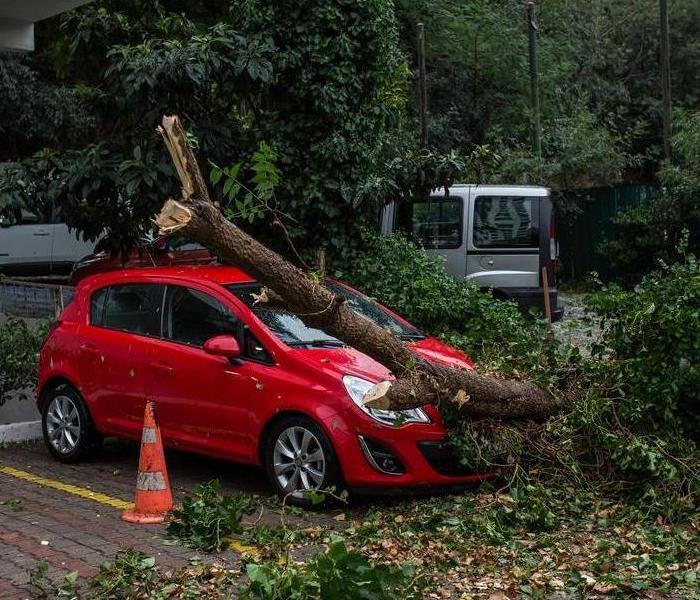 When unexpected storm, hail or wind damage befalls your home in Hamilton, OH, be prepared to act fast.
When unexpected storm, hail or wind damage befalls your home in Hamilton, OH, be prepared to act fast.
High winds, hail, and storms in Hamilton, OH, can cause significant roof damage. As a homeowner, you may know little about roof repair and even less about the process of mitigation. What is mitigation? When it comes to storm and wind damage, mitigation refers to the steps you need to take to stop additional loss from happening to your house before repairs begin.
How To Mitigate Roof Damage
Always prioritize your safety first. If high winds cause a tree to fall on your house, for example, evacuate and seek shelter elsewhere. Observe damage from the ground; do not climb onto the roof to inspect it yourself. Once you are safe, take the following steps to reduce secondary damage to your home:
• Install a tarp on your roof to prevent additional rain, hail and wind damage. The tarp remains on during the inspection and roof repair process. Contact a restoration company that offers emergency, professional roof tarping services. Until the professionals arrive, place buckets under the leaks to prevent further water damage.
• When a tree falls on the house, contact a tree service to remove the tree as soon as possible before the tarp is installed.
• If windows or skylights have broken, tape plastic over the openings until the glass is replaced.
How To Complete Restoration
After you have successfully mitigated the damage, take the necessary steps to complete the repairs:
• Contact a roofing company to repair the damaged areas.
• Address the water damage in your home. Work with a water restoration company to inspect, dry and restore your house and belongings.
• Check with your homeowner’s insurance agent to see if damages are covered under your policy.
When unexpected storm, hail or wind damage befalls your home in Hamilton, OH, be prepared to act fast. Immediately have a restoration company install a tarp to mitigate further problems. Promptly complete the roof repair and address any water damage that occurs inside your home. For more information, visit http://www.SERVPROwesthamiltonoxford.com/.
Preparing Your Business for Bad Weather: 3 Storm Protection Tips
6/13/2018 (Permalink)
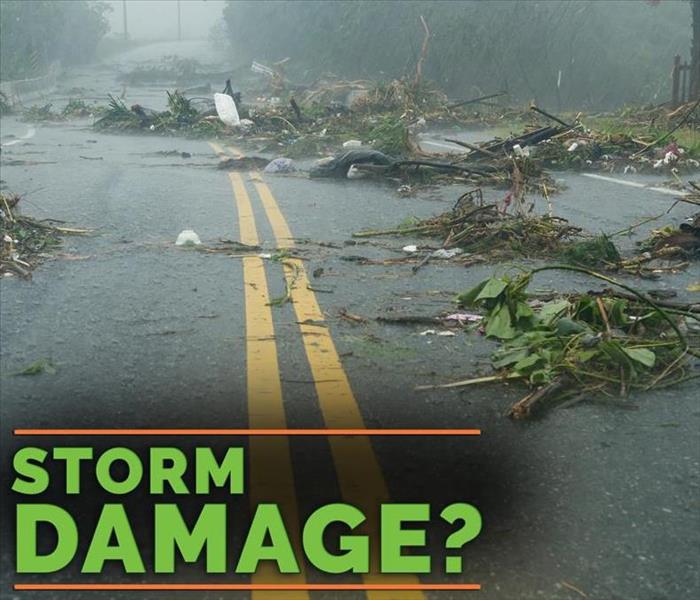 A heavy storm in Hamilton, OH, can have a serious impact on your business.
A heavy storm in Hamilton, OH, can have a serious impact on your business.
When bad weather strikes Hamilton, OH, it can seriously impact your commercial building and business operations. Power outages, cracked plumbing pipes, and roof damage can all occur during a heavy storm, causing hundreds or even thousands of dollars in damage. However, being prepared for bad weather may help protect your business and prevent loss of time, money and inventory. If bad weather is approaching, there are several steps you can take beforehand to ensure your building is equipped to withstand it.
1. Have Your Building Winterized
Having a pipe break in your breakroom or bathroom because of lower temperatures can not only be surprising, it may cause a serious flood. However, preparing your building for cold weather may help prevent this type of disaster. Working with a storm damage and restoration service might help you understand which areas of your property might be vulnerable during cold weather so you can have insulation added where necessary.
2. Be Aware of Weather Conditions
Once temperatures start to plummet, it is wise to track the weather and be aware of any storms that might be approaching the area. If a winter storm is projected to be especially powerful, you can prepare by shoring up your building’s windows with plywood to protect them from high winds and flying debris. Move any outdoor furniture or décor inside and store it away, and roll up your building’s awning to prevent it from tearing.
3. Have a Storm Plan in Place
Preparing your employees for bad weather can help your business teams act quickly in case a storm strikes during operational hours. Have an evacuation plan in place and discuss what protocol each individual should follow in case of a blackout. Being prepared can keep everyone safe when bad weather threatens the area.
A heavy storm in Hamilton, OH, can have a serious impact on your business. However, when you stay vigilant and prepared, you and your employees can act quickly to protect yourselves and your property. For more information, visit http://www.SERVPROwesthamiltonoxford.com/.




 24/7 Emergency Service
24/7 Emergency Service



















